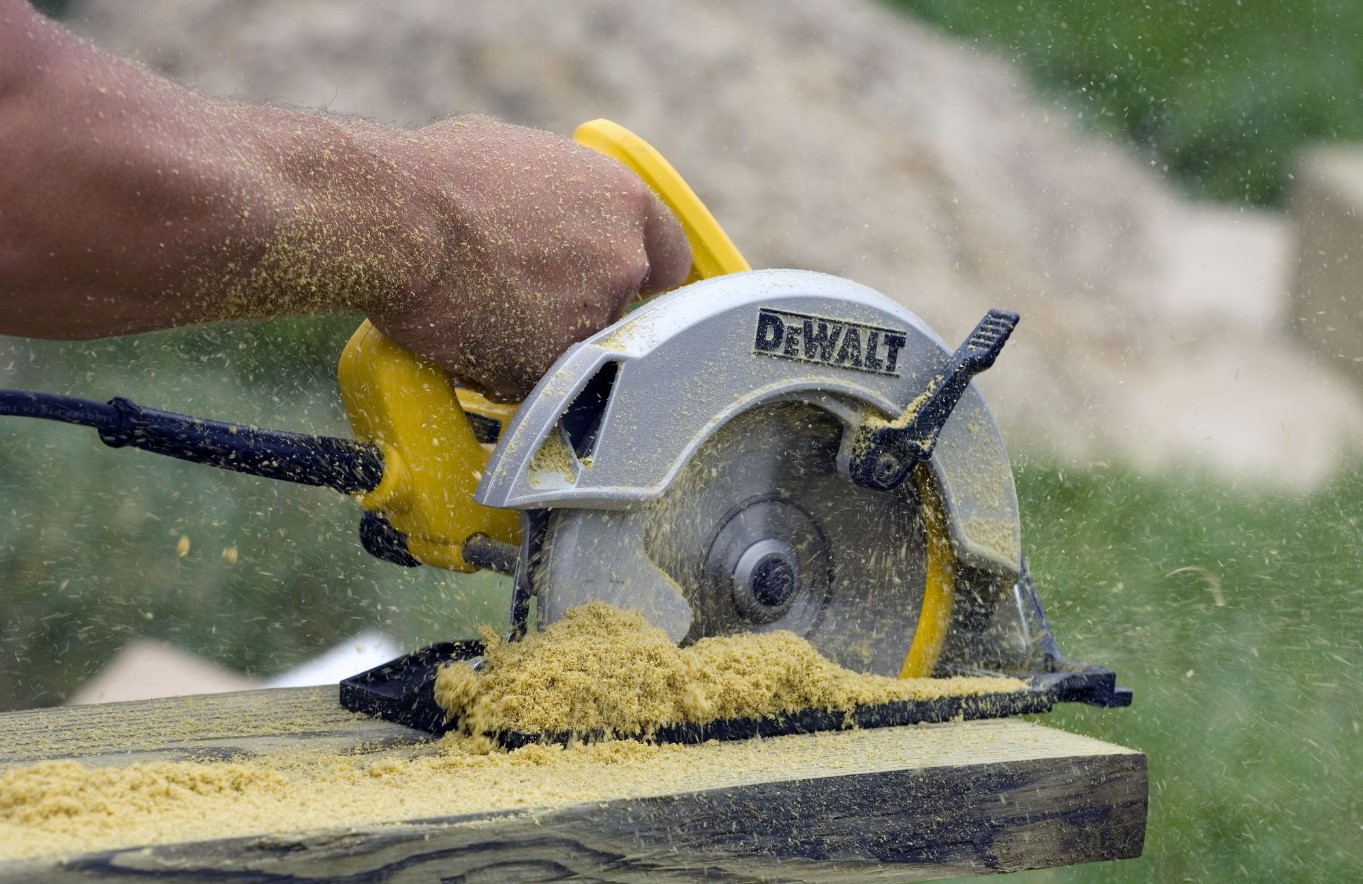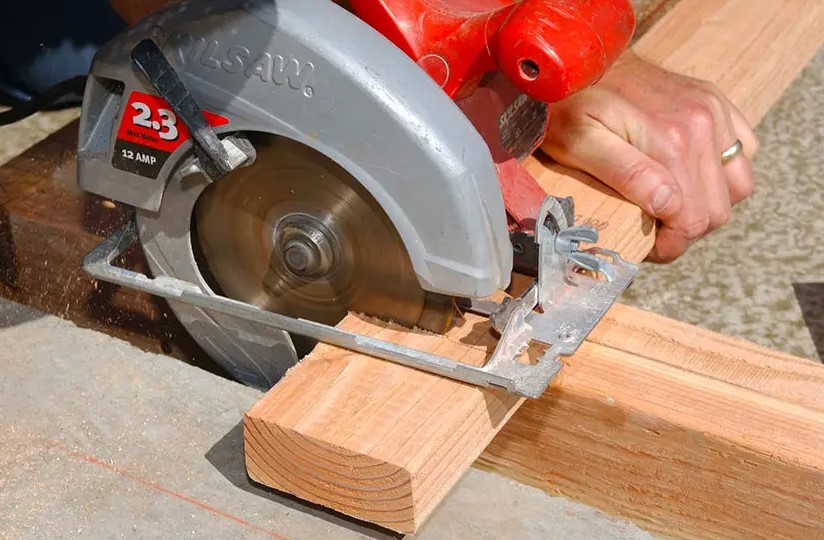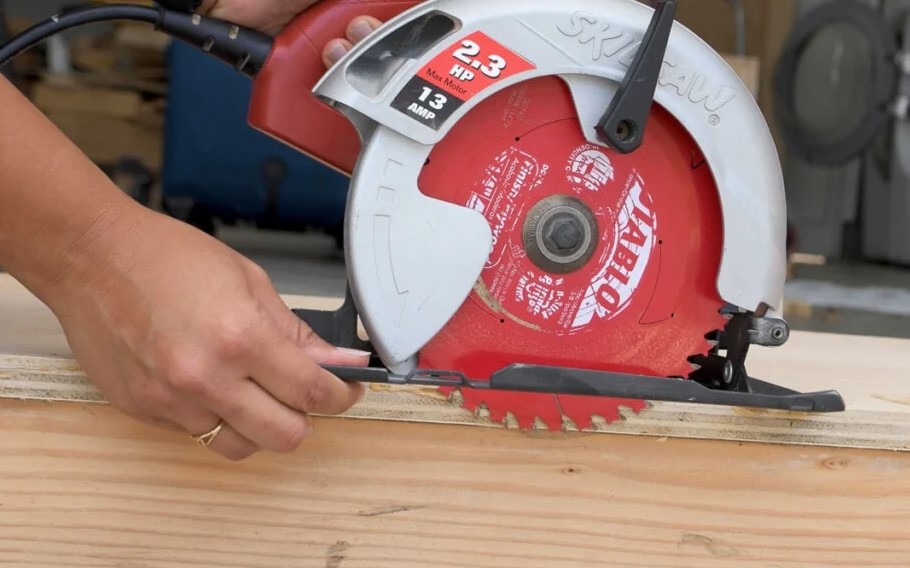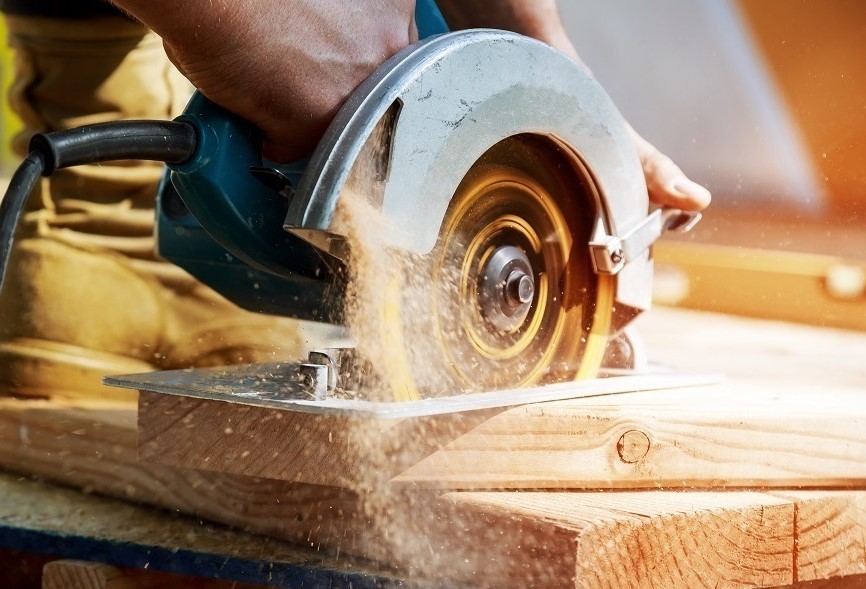Using a circular saw safely is of paramount importance, as it reduces the risk of accidents and ensures efficient cutting. However, when faced with the challenge of using a circular saw without a table, the task can become more demanding and potentially hazardous. This article aims to guide you through the process of using a circular saw without a table, offering step-by-step instructions while prioritizing safety. By following these guidelines, you can confidently and safely operate a circular saw in various scenarios, even without the use of a table.
Selecting the Right Circular Saw

When using a circular saw without a table, it’s crucial to select the right tool for the job. Consider the following key factors when choosing a circular saw:
- Power: Look for a circular saw with adequate power for the intended tasks. Higher amperage ratings generally indicate more cutting power.
- Blade Size: The blade size determines the maximum cutting depth of the saw. Consider the material thickness you’ll be working with to choose an appropriate blade size.
- Safety Features: Opt for a circular saw that includes essential safety features, such as blade guards and electric brakes. These features help prevent accidents and enhance user safety.
Here are some recommendations for circular saw models that are suitable for use without a table:
- Dewalt DWE575SB: This saw offers a powerful 15-amp motor and a 7¼-inch blade, making it versatile for various cutting applications. It also incorporates safety features like an electric brake and a dust blower for improved visibility.
- Makita 5007MG: With a magnesium construction, this circular saw is lightweight and durable. It features a 15-amp motor, a 7¼-inch blade, and advanced safety features like an electric brake and built-in LED lights.
- Bosch CS10: This saw boasts a 15-amp motor and a 7¼-inch blade. It offers excellent maneuverability and control, with features like a bevel adjustment and a soft-grip handle. It also includes a blade guard for added safety.
Remember to read customer reviews, compare prices, and consider your specific needs before making a final decision. The selected circular saw should align with your cutting requirements and provide the necessary safety features for a smooth and secure operation.
Preparing the Work Area
To ensure a safe and efficient cutting experience when using a circular saw without a table, proper preparation of the work area is essential. Follow these guidelines to create an optimal work environment:
- Clean and Well-Lit Area: Before starting any cutting task, clear the work area of debris, obstructions, or tripping hazards. A clean workspace allows for better focus and reduces the risk of accidents. Additionally, ensure there is ample lighting to provide clear visibility of the cutting area and the marked guidelines.
- Organized Setup: Keep your tools, accessories, and materials organized and within reach. This minimizes the chances of distractions and helps maintain a smooth workflow. Have a designated area for storing extra blades, measuring tools, and any other equipment you may need during the cutting process.
- Use Sawhorses or a Sturdy Workbench: When using a circular saw without a table, it’s crucial to have a stable and supportive surface to hold the material being cut. Utilize sawhorses or a sturdy workbench that can withstand the weight and vibrations caused by the saw. Ensure the sawhorses or workbench are set up on a level surface and securely positioned to prevent any movement during the cutting process.
By emphasizing a clean and well-organized work area and utilizing appropriate support structures like sawhorses or a sturdy workbench, you create a safer and more controlled environment for using a circular saw without a table. These measures not only enhance the stability of the workpiece but also provide you with better control over the cutting process, resulting in accurate and precise cuts.
Personal Protective Equipment (PPE)

When operating a circular saw without a table, wearing appropriate personal protective equipment (PPE) is crucial for your safety. Here’s why each PPE item is essential:
- Safety Goggles: Protecting your eyes with safety goggles is of utmost importance. They shield your eyes from flying debris, wood chips, and potential sawdust. Accidental contact with these materials can cause eye injuries that may lead to vision impairment or permanent damage.
- Ear Protection: Circular saws generate high levels of noise, which can be damaging to your hearing over time. Wearing ear protection, such as earmuffs or earplugs, reduces the risk of noise-induced hearing loss. It is recommended to use ear protection with a noise reduction rating (NRR) suitable for the noise level of the circular saw.
- Gloves: Proper hand protection is vital when handling a circular saw. Wear sturdy work gloves to protect your hands from potential cuts, abrasions, and splinters. The gloves also provide a better grip on the saw, enhancing control and reducing the risk of accidental slips.
PPE plays a significant role in preventing accidents and minimizing potential injuries while using a circular saw without a table. Here’s how:
- Injury Prevention: Safety goggles shield your eyes from flying debris, preventing eye injuries. Ear protection reduces the risk of long-term hearing damage caused by prolonged exposure to loud noises. Gloves provide a protective barrier against cuts and abrasions, reducing the likelihood of hand injuries.
- Minimized Health Risks: Wearing appropriate PPE lowers the risk of health issues associated with woodworking. Safety goggles protect against sawdust and wood particles that can cause respiratory problems. Ear protection reduces the risk of noise-related hearing loss, improving long-term auditory health.
By wearing the proper PPE, you significantly reduce the chances of accidents and potential injuries. Remember, safety should always be a priority when operating any power tool, and PPE is a fundamental component of maintaining a safe working environment.
Proper Blade Selection and Installation

Choosing the right blade for the material you’re cutting and properly installing it in your circular saw are essential for achieving clean and efficient cuts. Follow these steps to ensure proper blade selection and installation:
- Choosing the Right Blade:
a. Consider the Material: Identify the type of material you’ll be cutting, such as wood, metal, or plastic. Different materials require specific blade types to achieve optimal results.
b. Tooth Count: Determine the appropriate tooth count for the blade based on the material and the desired finish. Higher tooth counts provide smoother cuts, while lower tooth counts are better suited for faster and rougher cuts.
c. Blade Size: Ensure the blade size matches the saw’s specifications. Most circular saws accommodate blades ranging from 6 to 10 inches in diameter. - Installing the Blade:
a. Unplug the Saw: Before changing the blade, disconnect the circular saw from its power source to prevent any accidental activation.
b. Blade Orientation: Determine the correct blade orientation by checking the arrows or labels on the blade. The teeth should be facing forward in the direction of the saw’s rotation.
c. Blade Guard: Lift the blade guard using the designated lever or button to expose the blade arbor.
d. Blade Arbor Lock: Engage the blade arbor lock to prevent it from spinning. Use a wrench to loosen the arbor nut in the center of the blade.
e. Remove the Old Blade: Carefully remove the old blade, noting its orientation for reference.
f. Install the New Blade: Place the new blade onto the arbor, aligning the center hole of the blade with the arbor. Ensure it sits flush against the saw’s blade flange.
g. Tighten the Arbor Nut: Use the wrench to securely tighten the arbor nut, ensuring the blade is held firmly in place.
h. Lower the Blade Guard: Release the blade arbor lock and gently lower the blade guard back into its original position.
Proper blade selection and installation are crucial for achieving accurate and safe cuts. By choosing the appropriate blade for the material and following the step-by-step instructions for installing the blade in your circular saw, you can ensure smooth and efficient cutting operations. Always refer to the manufacturer’s instructions for your specific circular saw model to ensure proper installation.
Ensuring Material Stability
When using a circular saw without a table, ensuring the stability of the material being cut is crucial for accurate and safe cuts. Follow these techniques to properly secure the material and prevent movement during the cutting process:
- Clamping the Material:
a. Use Clamps: Use sturdy clamps to secure the material to a stable surface, such as sawhorses or a workbench. Place the clamps strategically to hold the material firmly in place.
b. Positioning: Position the clamps in a way that allows the cut line to be clear and accessible for the circular saw. Avoid placing clamps directly in the cutting path. - Using Guides:
a. Straight Edge Guide: Utilize a straight edge guide, such as a metal ruler or a straight piece of wood, to create a guide for the circular saw. Align the guide with the cut line, allowing the saw’s base plate to slide against it during the cut. This helps in maintaining a straight and accurate cut.
b. Track Systems: Some circular saws have track systems or guide rails designed for precise and guided cuts. Attach the saw to the track system and align it with the desired cut line. The track system provides stability and ensures accurate cuts.
The significance of preventing material movement during the cutting process cannot be overstated. Here’s why it is important:
- Accurate Cuts: When the material remains stable, there is less chance of the saw deviating from the intended cut line. This ensures cleaner, straighter cuts and prevents mistakes or errors that may result from material shifting during cutting.
- Safety: A securely held material reduces the risk of kickback, where the saw binds or gets caught in the material, causing the saw to jerk back towards the user. By preventing material movement, you minimize the chances of kickback and potential accidents.
By properly clamping the material or using guides, you ensure that it remains stable and firmly positioned during the cutting process. This allows for precise cuts while reducing the risk of accidents or mistakes. Prioritize material stability to achieve the best cutting results and maintain a safe work environment.
Correct Cutting Techniques

Properly holding and operating the circular saw is essential for achieving accurate and safe cuts when using it without a table. Follow these guidelines for different types of cuts and emphasize the importance of maintaining a steady and controlled cutting motion:
- Basic Holding and Operating Technique:
a. Grip: Hold the circular saw with both hands, one on the rear handle and the other on the front handle. Maintain a firm grip, ensuring your hands are positioned away from the blade and the cutting path.
b. Stance: Stand with your feet shoulder-width apart, maintaining a stable and balanced stance.
c. Sightline: Position yourself in a way that allows you to have a clear line of sight along the cutting path. - Rip Cuts (Cutting along the length of the material):
a. Marking the Cut Line: Measure and mark the desired cut line on the material using a pencil or a straight edge guide.
b. Positioning: Align the edge of the circular saw’s base plate with the cut line, ensuring the blade is clear of the material.
c. Starting the Cut: Place the saw’s front edge on the material, slightly away from the cut line. Activate the saw and gradually guide it along the marked cut line, maintaining a steady and controlled motion. - Cross Cuts (Cutting across the width of the material):
a. Marking the Cut Line: Measure and mark the desired cut line on the material using a pencil or a straight edge guide.
b. Positioning: Position the circular saw so that the blade will cut through the waste side of the material, away from the section you want to keep.
c. Starting the Cut: Place the saw’s front edge on the material, slightly away from the cut line. Activate the saw and guide it steadily across the marked cut line, maintaining control throughout the cut. - Bevel Cuts (Angled cuts):
a. Adjusting the Bevel: Use the bevel adjustment feature on your circular saw to set the desired angle for the cut.
b. Marking the Cut Line: Measure and mark the cut line on the material, considering the angle and bevel adjustment.
c. Executing the Cut: Position the saw’s base plate against the material and guide it steadily along the marked cut line, maintaining control and accuracy.
Maintaining a steady and controlled cutting motion is vital for several reasons:
- Accuracy: A steady hand and controlled motion ensure that the saw follows the marked cut line, resulting in precise and accurate cuts.
- Safety: A controlled cutting motion minimizes the chances of the saw deviating from the intended path, reducing the risk of accidents or injuries.
- Clean Cuts: Maintaining a steady motion prevents blade deflection or chatter, which can lead to rough or uneven cuts. A smooth and controlled motion produces cleaner and smoother edges.
By following proper holding and operating techniques, and emphasizing a steady and controlled cutting motion, you can achieve accurate, safe, and clean cuts with your circular saw. Practice these techniques to develop proficiency and enhance your cutting skills over time.
Safety Tips and Best Practices
When using a circular saw without a table, it’s crucial to prioritize safety at all times. In addition to the previously mentioned safety measures, here are some additional tips and best practices to ensure a safe working environment:
- Keep the Power Cord Away: Ensure the power cord is positioned away from the cutting area to prevent accidental contact with the blade. Use cord management techniques such as cord clips or cord keepers to keep the cord out of the way.
- Utilize Safety Features: Take advantage of the built-in safety features of your circular saw. These may include blade guards, electric brakes, and safety switches. Ensure they are properly adjusted and functioning before each use.
- Maintain a Clear Workspace: Keep the work area clear of any obstructions, clutter, or trip hazards. This includes tools, debris, and excess materials. A clear workspace allows for better maneuverability and reduces the risk of accidents.
- Avoid Freehand Cutting: Whenever possible, use guides or straight edge tools to guide the saw along the cut line. Freehand cutting increases the chances of veering off the desired path and can lead to inaccurate cuts or potential accidents.
- Do Not Force the Saw: Let the saw’s cutting speed and the blade do the work. Avoid forcing the saw through the material, as this can lead to kickback or loss of control. Apply gentle and consistent pressure, allowing the saw to cut at its intended pace.
Relevant statistics or studies regarding circular saw accidents and their causes underscore the importance of following safety protocols. While specific statistics may vary, it’s worth noting that improper use of circular saws can result in severe injuries, including lacerations, amputations, and eye injuries.
A study conducted by the National Institute for Occupational Safety and Health (NIOSH) identified common causes of circular saw accidents, including:
- Lack of proper training and experience in using circular saws.
- Failure to use personal protective equipment, such as safety goggles and gloves.
- Insufficient workspace organization, leading to material obstructions or trip hazards.
- Inadequate material support, resulting in material movement during cutting.
- Failure to follow manufacturer’s instructions and guidelines for safe operation.
These statistics and studies highlight the importance of adopting safe practices, utilizing personal protective equipment, and following proper guidelines when using a circular saw without a table. By prioritizing safety, you can significantly reduce the risk of accidents and ensure a secure working environment.
Maintenance and Care
Regular maintenance and care of your circular saw are crucial for its longevity, optimal performance, and, most importantly, safety. Follow these guidelines to ensure the proper maintenance, cleaning, lubrication, and storage of your circular saw:
- Regular Maintenance and Inspection:
a. Check Power Cord: Before each use, inspect the power cord for any signs of damage, such as cuts or fraying. Replace any damaged cords immediately.
b. Blade Condition: Regularly inspect the blade for any signs of wear, damage, or dullness. Replace the blade if it’s worn out or damaged.
c. Tighten Fasteners: Check all the screws, nuts, and bolts on the saw, including the blade arbor nut, and tighten them if necessary. Loose fasteners can affect the saw’s performance and compromise safety.
d. Trigger Safety: Ensure the trigger safety mechanism is functioning correctly. The trigger should only engage when intentionally pressed. - Cleaning the Saw:
a. Disconnect Power: Always unplug the saw before cleaning.
b. Remove Debris: Use a brush or compressed air to remove sawdust, chips, and debris from the saw’s housing, blade guard, and vents. Pay attention to any areas where debris may accumulate, such as the blade guard mechanism.
c. Clean the Base Plate: Wipe down the base plate with a clean cloth or brush to remove any residue or buildup.
d. Lubrication Points: Apply lubrication to the saw’s lubrication points, as recommended by the manufacturer. This ensures smooth operation and prevents excessive wear. - Blade Lubrication:
a. Blade Cleaning: After use, remove the blade and clean it with a blade cleaning solution or a solvent to remove any pitch or resin buildup. Follow the manufacturer’s instructions for cleaning and maintenance.
b. Lubricate the Blade: Apply a light coat of blade lubricant or silicone spray to the blade to prevent rusting and maintain its cutting efficiency. Be sure to wipe off any excess lubricant before using the saw. - Proper Storage:
a. Clean and Dry: Before storing the saw, ensure it is clean and free from any dust or debris. Allow it to dry completely to prevent moisture buildup.
b. Store in a Safe Location: Keep the saw in a secure and dry area, away from moisture, extreme temperatures, and direct sunlight.
c. Blade Protection: If possible, store the saw with a blade guard or use a blade cover to protect the blade from damage and accidental contact.
Regular maintenance, cleaning, lubrication, and proper storage of your circular saw contribute to its overall performance, durability, and safety. By following these tips, you can prolong the lifespan of your saw and ensure its optimal functioning whenever you need to use it. Always refer to the manufacturer’s instructions for specific maintenance guidelines and recommendations.
Troubleshooting Common Issues
While using a circular saw without a table, you may encounter some common problems. Here are a few issues that may arise and troubleshooting tips to help you address them:
Blade Binding:
- Issue: The blade gets stuck or binds in the material, preventing smooth cutting.
- Troubleshooting: Check if the blade is sharp and suitable for the material being cut. Ensure the blade is properly installed and tightened. Slow down your cutting speed and apply gentle pressure to avoid overloading the blade. Clear away any debris or sawdust that may be causing the binding.
Inaccurate Cuts:
- Issue: Cuts are not straight or accurate, deviating from the intended cut line.
- Troubleshooting: Ensure that you are using guides or straight edge tools to guide the saw along the cut line. Double-check that the blade is properly aligned with the cut line before starting the cut. Maintain a steady and controlled cutting motion, avoiding excessive force or veering off the intended path.
Excessive Tear-out:
- Issue: The material being cut shows significant tear-out or splintering.
- Troubleshooting: Use a fine-toothed blade with more teeth for smoother cuts. Apply masking tape along the cut line to minimize tear-out. Adjust the cutting speed to avoid pushing the saw too fast through the material. Consider placing a sacrificial backing material beneath the workpiece to reduce tear-out.
Saw Blade Wobbling:
- Issue: The blade wobbles or vibrates excessively during operation.
- Troubleshooting: Check if the blade is securely tightened and properly installed. Ensure the arbor nut is tightened adequately. If the blade itself is damaged or worn, replace it. Excessive blade wobbling can also be caused by a bent or damaged arbor or spindle. Consult a professional if this issue persists.
Motor Overheating:
- Issue: The saw’s motor becomes hot during use, leading to decreased performance or potential damage.
- Troubleshooting: Check if the saw is being overloaded by attempting to cut materials that exceed its capacity. Reduce the cutting speed and allow the motor to cool down if it becomes too hot. Keep the air vents of the saw clean and clear of debris to ensure proper ventilation.
If you encounter any other issues or problems while using your circular saw without a table, refer to the manufacturer’s manual for specific troubleshooting advice. If the problem persists or if you’re uncertain about how to address it, it’s recommended to consult a professional or contact the manufacturer for further assistance.
Conclusion:
In this article, we have explored the topic of using a circular saw without a table while prioritizing safety. Here’s a summary of the key points discussed:
- Selecting the Right Circular Saw: Consider factors such as power, blade size, and safety features when choosing a circular saw suitable for use without a table.
- Preparing the Work Area: Emphasize the importance of a clean, well-lit, and organized workspace. Use sawhorses or a sturdy workbench to support the material being cut.
- Personal Protective Equipment (PPE): Wear appropriate PPE, including safety goggles, ear protection, and gloves, to prevent accidents and minimize potential injuries.
- Proper Blade Selection and Installation: Choose the right blade for the material and follow step-by-step instructions for installing and securing the blade in the circular saw.
- Ensuring Material Stability: Secure the material being cut using clamps or guides to prevent movement during the cutting process, ensuring accuracy and safety.
- Correct Cutting Techniques: Hold and operate the circular saw properly for different types of cuts. Maintain a steady and controlled cutting motion for accurate results.
- Safety Tips and Best Practices: Additional safety tips include keeping the power cord away from the cutting area, utilizing safety features, and maintaining a clear workspace.
- Maintenance and Care: Regularly maintain and inspect the circular saw, clean it, lubricate the blade, and store it properly to ensure longevity, performance, and safety.
- Troubleshooting Common Issues: Identify common problems such as blade binding, inaccurate cuts, tear-out, blade wobbling, and motor overheating. Offer troubleshooting tips to address these issues.
It is essential to emphasize the importance of following safety guidelines when using a circular saw without a table. Safety precautions, such as wearing proper PPE, securing the material, and practicing correct cutting techniques, significantly reduce the risk of accidents and injuries. Prioritizing safety should always be at the forefront of every woodworking project.
Lastly, I encourage readers to practice and develop good habits when using a circular saw. Regularly review and reinforce safety guidelines, seek proper training if needed, and take the time to understand and utilize the features of your specific circular saw model. By cultivating these habits, you can ensure safe and effective use of the circular saw, enabling you to accomplish your woodworking tasks with confidence and precision.